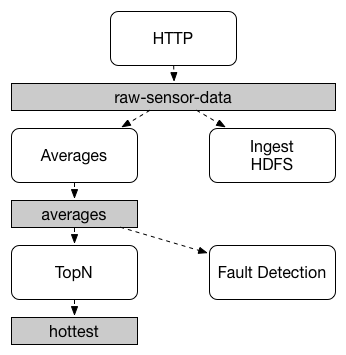|
This version is still in development and is not considered stable yet. For the latest stable version, please use spring-cloud-stream 4.3.0! |
Persistent Publish-Subscribe Support
Communication between applications follows a publish-subscribe model, where data is broadcast through shared topics. This can be seen in the following figure, which shows a typical deployment for a set of interacting Spring Cloud Stream applications.

Data reported by sensors to an HTTP endpoint is sent to a common destination named raw-sensor-data.
From the destination, it is independently processed by a microservice application that computes time-windowed averages and by another microservice application that ingests the raw data into HDFS (Hadoop Distributed File System).
In order to process the data, both applications declare the topic as their input at runtime.
The publish-subscribe communication model reduces the complexity of both the producer and the consumer and lets new applications be added to the topology without disruption of the existing flow. For example, downstream from the average-calculating application, you can add an application that calculates the highest temperature values for display and monitoring. You can then add another application that interprets the same flow of averages for fault detection. Doing all communication through shared topics rather than point-to-point queues reduces coupling between microservices.
While the concept of publish-subscribe messaging is not new, Spring Cloud Stream takes the extra step of making it an opinionated choice for its application model. By using native middleware support, Spring Cloud Stream also simplifies use of the publish-subscribe model across different platforms.

